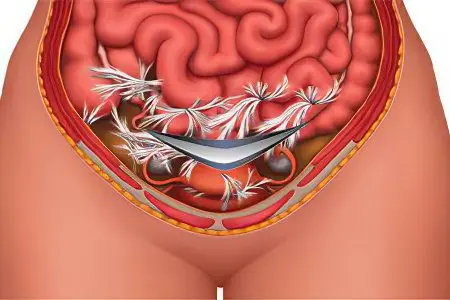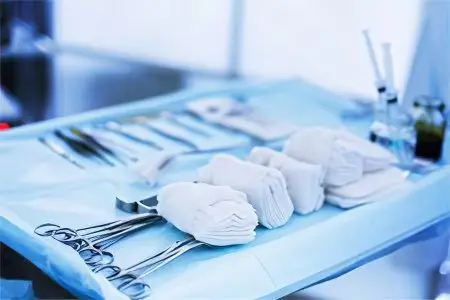Contents
Intestinal adhesions are formations of connective tissue (strands) between the abdominal organs and intestinal loops, leading to fusion or gluing of the serous membranes of the organs to each other. As a result, they merge with each other, which leads to a wide variety of functional disorders. The bands themselves are made up of the same tissue as the outer wall of the intestine. Most often, this pathological process is caused by a previous surgical intervention.
According to statistics, if a primary laparotomy intervention was performed on the intestine, then adhesions will form in 14% of cases, and if this is the third operation in a row, then they occur in 96% of cases.
Causes of intestinal adhesions

To determine the causes of intestinal adhesions, one should understand the mechanism of their occurrence. It is known that all organs located in the abdominal cavity, including the intestines, are covered with thin sheets of peritoneum. These sheets are smooth and produce a small amount of fluid that keeps the intestines moving. When there is an impact of one or another factor on the intestine, this leads to the formation of its edema and the formation of fibrin plaque on the sheets of the peritoneum. This plaque has a sticky consistency and helps to ensure that adjacent tissues are connected to each other. If there is no adequate treatment at a given time, then adhesions will form at the site where there was inflammation and adhesion occurred.
They do not form instantly, but go through several stages. First, fibrin appears, after 2 days it acquires fibroblasts that secrete collagen. On the 7th day, inflamed tissues begin to be replaced by connective ones. This process is completed after 3 weeks. This time is enough for the formed adhesions to turn into adhesions. In the future, nerves and capillaries sprout in them.
The causes of intestinal adhesions are due to the following factors:
The primary reason for the formation of intestinal adhesions are surgical manipulations on the organ. This may be an operation to remove an appendix, a caesarean section, an operation to remove a polyp or other neoplasm. That is, any internal inflammation of the intestine, which ended with surgery, can lead to the formation of strands. Against the background of infection of inflammation, when the peritoneum dries out during surgery and with other negative factors, the risk of developing adhesions increases.
Abdominal injuries, both open and closed. Mechanical damage is often accompanied by internal bleeding. Hematomas can occur on the intestines, lymphatic outflow suffers, metabolic processes in its tissues are disturbed. As a result, the blood flow is disturbed, inflammation occurs and a spike is formed.
In women, intestinal adhesions can form due to inflammation of the appendages.
In childhood, intestinal adhesions can form as a result of congenital anomalies in the development of the organ.
Foreign bodies in the peritoneum and the intake of certain medications provoke adhesions.
Additional risk factors for the formation of intestinal adhesions are:
Mechanical intraoperative trauma;
Ischemia of intestinal tissues;
Imposition of non-absorbable sutures;
Postoperative infection;
Decreased local immunity;
Blood in the abdominal cavity;
Hyperactivity of the connective tissue, as an individual feature of the organism;
The tendency to form adhesions, inherited.
Symptoms of intestinal adhesions

Symptoms of intestinal adhesions depend on what time a person has intestinal obstruction. It can develop both in the early period after an operation or injury, or a little later – several months or even years after exposure to a provocative factor.
Symptoms of early adhesive bowel disease
Symptoms indicating the formation of adhesions in the first days after an injury or operation are often veiled by the intervention itself. A person complains of periodically increasing pain in the abdomen, which is to some extent present on an ongoing basis. As the pathological process progresses, the pain becomes cramping.
Vomiting joins, which becomes very frequent and plentiful.
If the patient has a probe inserted, the amount of fluid to be separated will increase.
There is bloating, but it is not uniform, as usual, but asymmetrical. This is due to the fact that certain parts of the intestine are filled with gases.
On palpation, the patient complains of pain. Even stroking the abdominal wall causes increased intestinal peristalsis and discomfort.
The chair is missing. Conducted enemas allow you to hang out only small amounts of feces.
A simple form of adhesive obstruction develops against the background of improvement after surgery. As a rule, this happens 5-14 days after its completion. Her symptoms are clear and do not raise questions in terms of diagnosis. There are sudden sharp pains, vomiting of gastric contents with bile impurities begins. The abdomen is swollen unevenly, gases and stools at the initial stage of the formation of adhesions can move away on their own.
It is characteristic that after a few hours the patient’s condition will worsen, vomiting will intensify, signs of dehydration will join, the tongue will become dry, covered with a white coating. Gases cease to depart, the chair disappears.
If early adhesive obstruction of the intestine is formed against the background of an inflammatory process, then in addition to all the symptoms, the body temperature rises. An inflammatory infiltrate can be palpated in the intestine, which is represented by a compacted area.
Separately, it is worth noting the early delayed adhesive disease of the intestine, which manifests itself on the 21-30th day after exposure to a provoking factor. Symptoms develop gradually, with a tendency to increase. Often this happens even against the background of a successfully completed operation after being discharged home.
Symptoms of late adhesive intestinal obstruction
Symptoms develop months or years after the intervention. It is possible that the acute process will be preceded by pain in the lower abdomen.
Suddenly, a person manifests severe pain of a cramping nature. As the process progresses, they occur more and more often and become stronger.
Vomiting starts. There is no stool or gas.
The abdomen acquires an asymmetric shape, this is especially noticeable in the place where there are adhesions. The intestinal loop is filled with gases.
The patient’s condition will worsen as dehydration and intoxication increase. Subsequently, intestinal paresis will join if emergency care is not provided.
Diagnostics

Diagnosis of intestinal adhesions is built on examining the patient and identifying characteristic symptoms. The doctor may suspect the formation of strands when collecting an anamnesis. An indicator is the transferred surgical interventions on the intestines, the presence of an infectious pathology.
To clarify the diagnosis, the following research methods are used:
Survey radiography of the abdominal cavity. Thanks to this method, it is possible to visualize the presence of inflammatory exudate, the presence of a large amount of gases in the intestine, and its swelling. Often x-rays are performed with the introduction of a specialized dye. This gives additional information about its patency. This procedure is called irrigography, in this case barium acts as a contrast agent.
Electrogastroenterography allows you to measure the electrical impulses that come from the intestines during its peristalsis.
Ultrasound and MRI can accurately determine the place where the adhesions are located, as well as determine their number.
The most informative method for detecting adhesions is a laparoscopic examination. However, it is a small operation that requires incisions in the abdomen and the introduction of instrumentation equipped with a camera into its cavity. The undoubted advantage of this procedure is that if the doctor sees a problem, he can immediately eliminate it. That is, intestinal adhesions can be removed during diagnosis.
As for laboratory tests, you will need to donate blood to exclude the presence of inflammation. It is important to make a differential diagnosis with other types of acute intestinal obstruction, which may be caused by intestinal strictures or large tumors.
Is it possible to do a colonoscopy with intestinal adhesions?
Colonoscopy with intestinal adhesions can be done, since their presence is not an absolute contraindication to the procedure. However, some experts recommend that the study be performed under intravenous anesthesia. This is because adhesive processes can cause severe pain during the procedure.
If the patient requires a colonoscopy, but there is a suspicion of adhesive disease, then it is better to start with barium enema. A study using a colonoscope should be carried out only in the case of low information content of barium enema.
How to treat intestinal adhesions?
Treatment of intestinal adhesions involves performing surgery. It is still not possible to remove the formed fibrous fibers by medication. This is especially true for old, strong and dense adhesions.
However, conservative treatment is not completely rejected. It is necessary in order to prevent the formation of new strands, to stop the symptoms and prevent complications of the disease.
When a patient arrives with an exacerbation of intestinal obstruction, then for a start, it is necessary to eliminate the pain symptom. To do this, the patient is given a cleansing enema, which allows gases and feces to come out. Heat is applied to the stomach (if there is no purulent inflammation), antispasmodics are prescribed. If the patient’s condition has not returned to normal after 2-3 hours, then surgery is indicated, since there is a risk of developing necrosis of the intestinal sections. When it was possible to remove the obstruction, the patient is carefully monitored.
The decision on surgical intervention should be clear and balanced, since the risk of recurrence of the disease is quite high. It is possible that to prevent the next exacerbation of the disease will allow conservative treatment and diet. So, frequent constipation can be eliminated with the help of a special diet. To do this, the menu includes foods rich in fiber, sour-milk drinks. If constipation cannot be eliminated in this way, then the patient is prescribed laxatives.
Physiotherapy is also useful, including: paraffin baths, diathermy, iontophoresis. Physical activity that has a negative effect on spasm of the intestinal muscles will need to be excluded. To eliminate vomiting, antiemetics are indicated, the introduction of intravenous solutions to prevent dehydration.
When surgery is unavoidable, preoperative preparation must be of high quality. However, emergency operations are often required when there is simply no time for proper preparation. Patients are urgently transfused with plasma, sodium chloride, Ringer-Locke solution, which makes it possible to prevent dehydration. Prednisolone in combination with Reopoliglyukin allows you to remove intoxication from the body.
During surgery, old scars are not excised, as this can be dangerous. Indeed, often the walls of the intestines are soldered to them. The adhesions are divided, pushed apart, and then removed. The technique of their excision is determined depending on the specific situation. Intestinal resection is performed if areas of necrosis are found.
The imposition of a bypass anastomosis is performed when adhesions have deformed the intestine.
It is important already during the operation to carry out preventive measures aimed at preventing the recurrence of the adhesive process. To do this, the incisions are made wide, do not allow the peritoneal petals to dry out. Blood must be removed in a timely manner, and bleeding must be stopped completely. The introduction of dry antibacterial drugs or anesthetics into the wound is unacceptable. The wound is sutured with polymer threads. It is mandatory to exclude the ingress of any foreign particles into the wound.
When the operation is completed, proteolytic enzymes are injected into the peritoneum. The patient is shown taking drugs from the group of NSAIDs, antihistamines, stimulation of intestinal motility.
As for the prognosis, it is favorable with single spikes. If the adhesions are multiple, then in 15-20% of cases they re-grow. To prevent the formation of adhesions, you need to eat right, exercise, avoid both overeating and starvation. Treatment of intestinal pathologies should be performed as early as possible, which requires regular examinations by a gastroenterologist. Naturally, the qualifications and professionalism of doctors performing surgery on the intestines play a leading role in terms of the occurrence of adhesions on its surface.









